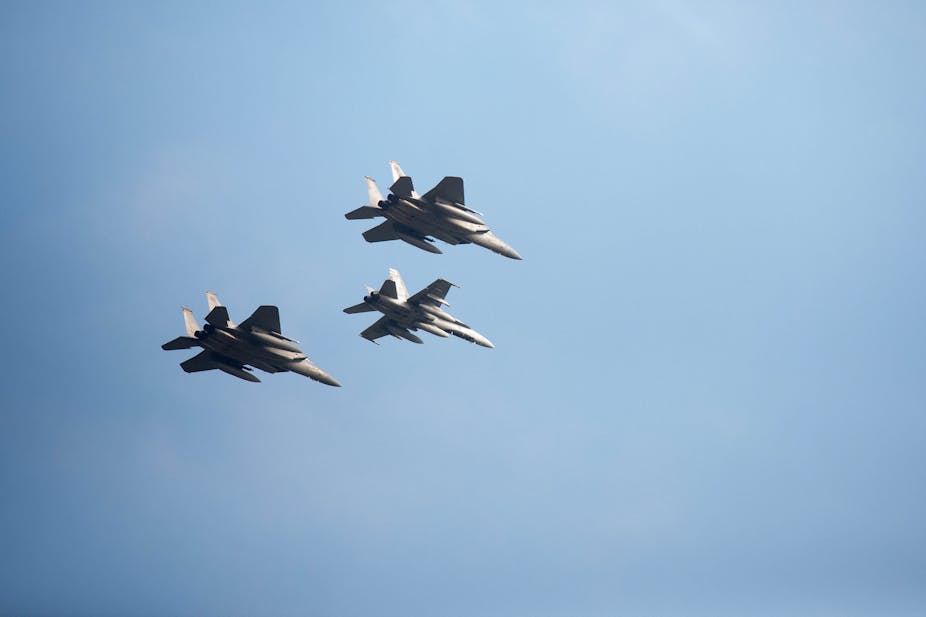The expansion of airstrikes against Islamic State (IS) into Syria announced yesterday by US President Barack Obama marks a predictable, if necessary, escalation of coalition operations against the jihadist insurgent group. Debates over the wisdom of the operation aside, any military campaign aiming to cripple IS (also known as ISIL or ISIS) as an organisation must target its core logistical and command and control hubs. Most of these appear still to be based in Syria’s east.
The Syrian government, however, remains understandably suspicious of coalition intentions in its backyard. A senior minister in the Assad government, Ali Haidar, warned that any action undertaken without the approval of Damascus would be considered “an aggression against Syria”.
Haidar’s statement reflects a common concern among Assad loyalists. They view the prospect of any coalition activity inside Syria proper as a potential precursor to direct intervention and regime change. But after three-and-a-half gruelling years of war, is the Syrian regime still in a position to resist outside aerial encroachment and threaten coalition operations?
Down but not out
The simple answer is yes. The civil war has taken a heavy toll on the ground troops and air power of the Syrian Arab Armed Forces (SAAF), but its air defences have remained largely unaffected. While not the most advanced in the world, Syrian anti-air systems still pose a considerable threat.
According to the annual defence report of the International Institute for Strategic Studies, Damascus has access to modern Russian platforms. These include the Pantsir-S1, the Strela-10 and the likely culprit in the MH17 tragedy, the Buk/Buk-M2. Despite repeated discussions over the potential deployment of the formidable theatre-level S-300 system, its status in Syrian hands remains ambiguous.
Such weapons were responsible for the downing of a Turkish warplane along the Syrian periphery in 2012, sparking a minor diplomatic crisis. Closer to home and several decades earlier in 1983, the SAAF used similar platforms to down two US Navy aircraft in Lebanese airspace, much to the consternation of the Reagan administration. Last year, Israel had concerns over the deployment of the Buk in southern Syria and its potential transfer to Lebanese Hezbollah. The IDF launched a devastating airstrike near Damascus to destroy the weapons before they could reach their destination.

The Syrian regime couldn’t hope to fend off a direct assault by the US and its partners. However, it could disrupt an operation against IS. This could have severe political consequences and lead to a rapid escalation and regionalisation of the conflict.
Given IS’ positioning inside Syria, coalition air strikes will likely be centred on the eastern city of Raqqah, where the group has made a serious effort to establish itself. While SAAF forces have lost considerable ground since 2011, they nevertheless hold territory within 50 kilometres of the city. This counts much of the government arsenal out, but still leaves systems like the Buk as a credible threat to coalition aircraft.
As the 1999 NATO bombing of Yugoslavia showed, even the stealthiest of aircraft can be downed by relatively low-grade Russian and Soviet equipment.
Dealing with the devil
Until now, the US and its allies have been able to engage IS in Iraq with impunity. The greatest threats they face have been pilot error and equipment failure. Syria is not Iraq, however, and the replication of such invulnerability in Levantine airspace is predicated on an understanding between the Assad government and intervening forces.
Given that much of the coalition has spent the past three years calling for the regime’s immediate dissolution and has just committed to expanding support for its opposition, this is a daunting task on both sides of the aisle.
Some may bank on the regime simply taking a step back and allowing one enemy to kill another. It seems to have been more than happy to employ this strategy against warring factions in the opposition. Yet not securing some form of information-sharing relationship between Washington and Damascus leaves far greater room for mishap.
With a considerable portion of the international community now committed to direct involvement in the Syrian conflict, the possible ramifications of such avoidable errors are dire.

